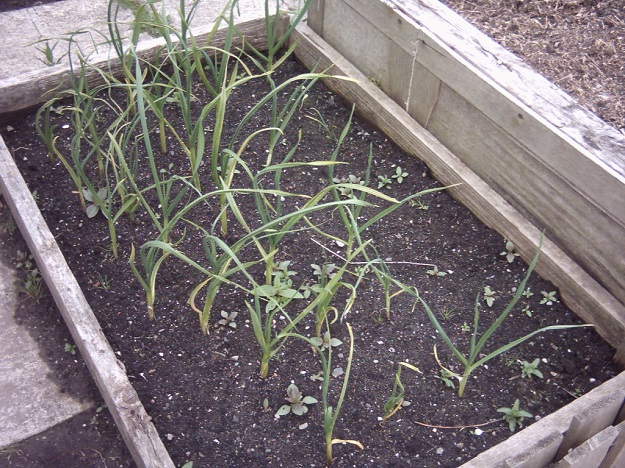I am always surprised when I see a vegetable garden during the cooler months and there is no garlic. Garlic is easy to grow and has properties fresh from the garden that can not be matched with the dried store-bought varieties. Professional chefs know that the richest flavor is found in the freshest cloves and greens. Yes, that is right; the greens are a delicacy known as green garlic that has wonderful qualities different from the cloves.

When and How to Plant
Fall is the time to start planting garlic. Depending on the climate in your area, this is generally between September and late October. It is best to plant some garlic early enough for a large root system to develop before winter begins. The plants will grow foliage rapidly until winter begins and then will appear to stop growing. Never fear! The plants will take off rapidly in early spring as soon as the temperatures begin to warm a bit. Garlic can be planted in succession until early spring, and it is best to keep planting after the initial crop is planted for continual use in the kitchen.
There is nothing to planting. Simply poke bulbs into the soil an inch or so deep with the pointed end up. Space them 3-6 inches apart, keep moist and they will come up in a couple of weeks. The largest bulbs will produce the best results so use smaller bulbs in the kitchen and only plant the big ones. If you want to speed things up a bit, soak the bulbs for a couple of days before planting.
Garlic likes well drained soil. It is best to incorporate compost and/or other organic material into the soil, and mulch on top to keep weeds at bay over the winter. A balanced fertilizer may be applied in two-week intervals when the plants begin to grow rapidly in spring. For the garlic that will be picked early to serve the kitchen throughout fall, winter, and spring, it works well to just poke bulbs into your container gardens wherever there is space.
Companion Planting
Garlic is a great crop, but it has additional benefits for other plants in the garden. The main benefits of garlic as a companion plant are its natural fungicidal and pesticidal properties which can help keep neighboring plants healthy. Garlic planted near lettuce and cabbage is especially helpful where it deters aphids and many other common pests. Garlic is even known to improve the flavor of some its’ neighboring plants. Garlic does not do well with legumes, beans, peas, or potatoes so do not plant garlic too near these plants. If companion planting interests you, read this article to learn more about it.
Green Garlic – The Cooks Secret
So, you have a nice quantity of garlic planted in spring. You will want to leave this alone for full season clove harvesting and continue planting cloves for use in the kitchen throughout the fall, winter, and spring.
In only about two weeks after the sprouts appear plants will be 4-6 inches tall and look like green onions. Leave those planted first alone to grow, but others can be harvested at this stage, and you will not be disappointed. Simply pull out the bulb and dice the bulb and green section for cooking. A good strategy is to plant a bulb in the place of each one your harvest early.
This early garlic is milder than dry garlic and a much larger quantity can be used in cooking than what is normally used with dried garlic. Start by pulling a few bulbs, dicing them with the greens and sautéing in extra virgin olive oil to serve over pasta. You will be amazed with the mild garlic flavor and be encouraged to use larger quantities in many of your dishes. As the garlic matures, the bulbs will get bigger and can be used for cooking along with the greens at any stage of the game. They will appear to be like a small onion as individual cloves will not have formed yet, but they are even easier to prepare for cooking than dried garlic because there is no messy dried skin to remove. Simply pull off the roots at the bottom, rinse, and chop.
Varieties to Try
Interesting varieties are available from seed catalogs, but there is nothing wrong with planting cloves bought at the grocery. There are three basic types of garlic and many gourmet varieties. The basic varieties are hardneck, softneck and elephant. Elephant garlic is not a true garlic, but rather a variety of leek with a mild garlic flavor. Softneck varieties are the best type to use for braiding and have the best storing qualities, so these are the ones to plant early and let go full term. Many people also think softneck varieties have the best flavor, and it is the variety most commonly available at grocery stores, so you have easy access to bulbs for planting. Hardneck varieties have fewer cloves per bulb and are available in several different flavors and skin colors. They have a reputation for being more difficult to grow, but still are worth giving a try.
Harvesting
Some types of garlic will develop a flower stalk in the spring. Just like with your cooking herbs, cut out the flower stalk so the energy goes into the bulb. By the middle of summer, the leaves of the garlic will begin to turn brown. When the leaves have died back about halfway, it is time to harvest. The bulbs dry well in a shaded area with a small fan. After drying, cut off the roots and tops and store in the refrigerator. This will be the garlic that you can use for summer until spring comes again and you can start planting. After one season, you will be hooked and hankering for that fresh garlic again.
Nick Fraser is a free-lance writer and greenhouse enthusiast.
Related Articles & Free Email Newsletter Sign Up
Dried Herbs Require Little Work and Offer a Great Reward




Comment here